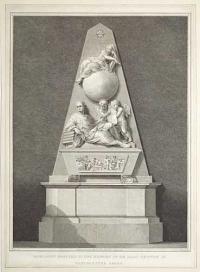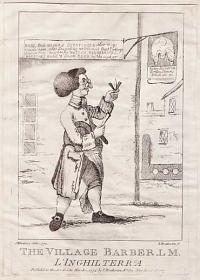Results 1-4 of 4
<<< Previous 1 Next >>>
![[26 Bound plates of Astronomy]](img-thumbnail/jpegs/59550.jpg)
[26 Bound plates of Astronomy] Astronomie.
Goussier Del. Benard Fecit.
[n.d. c.1750]
Bound engravings, plates 350 x 220mm (13¾ x 8¾"), with large margins. No cover.
Images of astronomical diagrams, instruments and astrology. Louis-Jacques Goussier (1722 - 1799) was a French illustrator and encyclopedist. Louis-Jacques Goussier is famous for his work on Diderot's encyclopedia. He was the first drawer to be hired on that project, in 1747 and he did himself more than 900 plates and directed the drawing of the others. Robert Bénard (1734 – 1777) was a French engraver. Specialized in the technique of engraving, Robert Bénard is mainly famous for having supplied a significant amount of plates (at least 1,800) to the Encyclopédie by Diderot & d'Alembert from 1751.
[Ref: 59550] £600.00
view all images for this item
![[John Hunter.]](img-thumbnail/jpegs/59592.jpg)
[John Hunter.]
[Lithographed by J. Allport? after Sir Joshua Reynolds.]
[n.d., c.1840].
Rare lithograph. Sheet 455 x 355mm (18 x 14"). Trimmed, losing inscriptions.
A portrait of Scottish surgeon and anatomist John Hunter (1728-93) seated at a table surrounded by anatomy books and artifacts, quill in hand. W: 1475
[Ref: 59592] £280.00
(£336.00 incl.VAT)

Monument Erected to the Memory of Sir Isaac Newton in Westminster Abbey.
Byley del. Fittler sculp.
Published by R. Bowyer, Historic Gallery, Pall Mall _ May 20, 1794.
Trimmed to plate, glued on album sheet at edges.
Obelisk shaped monument with relief sculpture, Newton reclining on top of a casket or sarcophagus decorated with frieze; he gestures towards a scroll held by two cherubs to right, a female figure relining on a globe above at top. Sir Isaac Newton FRS (1643 - 1727) was an English physicist, mathematician, astronomer, natural philosopher, alchemist, and theologian who is perceived and considered by a substantial number of scholars and the general public as one of the most influential men in history. His 1687 publication of the Philosophiæ Naturalis Principia Mathematica is considered to be among the most influential books in the history of science, laying the groundwork for most of classical mechanics. In this work, Newton described universal gravitation and the three laws of motion which dominated the scientific view of the physical universe for the next three centuries. Newton showed that the motions of objects on Earth and of celestial bodies are governed by the same set of natural laws by demonstrating the consistency between Kepler's laws of planetary motion and his theory of gravitation, thus removing the last doubts about heliocentrism and advancing the scientific revolution. In mechanics, Newton enunciated the conservation principles of momentum and angular momentum. In optics, he built the first practical reflecting telescope and developed a theory of colour based on the observation that a prism decomposes white light into the many colours that form the visible spectrum. He also formulated an empirical law of cooling and studied the speed of sound. In mathematics, Newton shares the credit with Gottfried Leibniz for the development of the differential and integral calculus. He also demonstrated the generalised binomial theorem, developed the so-called "Newton's method" for approximating the zeroes of a function, and contributed to the study of power series. From Bowyer's edition of David Hume's 'History of England'.
[Ref: 59530] £130.00
(£156.00 incl.VAT)

The Village Barber L.M. L'Inghilterra.
HW Bunbury delin: 1772. J. Bretherton f.
Publish'd as the Act directs March 1772 by J.Bretherton No.134 New Bond Street.
Etching. 260 x 175mm (10¼ x 7"). Trimmed close to platemark top and bottom, laid on album paper.
A caricature of a country barber-surgeon, depicting a bespectacled man holding a lancet, razor and a bowl for shaving or blood letting. Above is a shop sign of a wig. Behind are the village stocks. According to Wellcome 'L.M.' is an abbreviation for 'Licentiate in medicine', a qualification to practise medicine or surgery, bestowed by a bishop or archbishop. BM Satire 4757. Wellcome 29464i.
[Ref: 59576] £160.00
(£192.00 incl.VAT)
<<< Previous 1 Next >>>
![[26 Bound plates of Astronomy]](img-thumbnail/jpegs/59550.jpg)
![[John Hunter.]](img-thumbnail/jpegs/59592.jpg)

